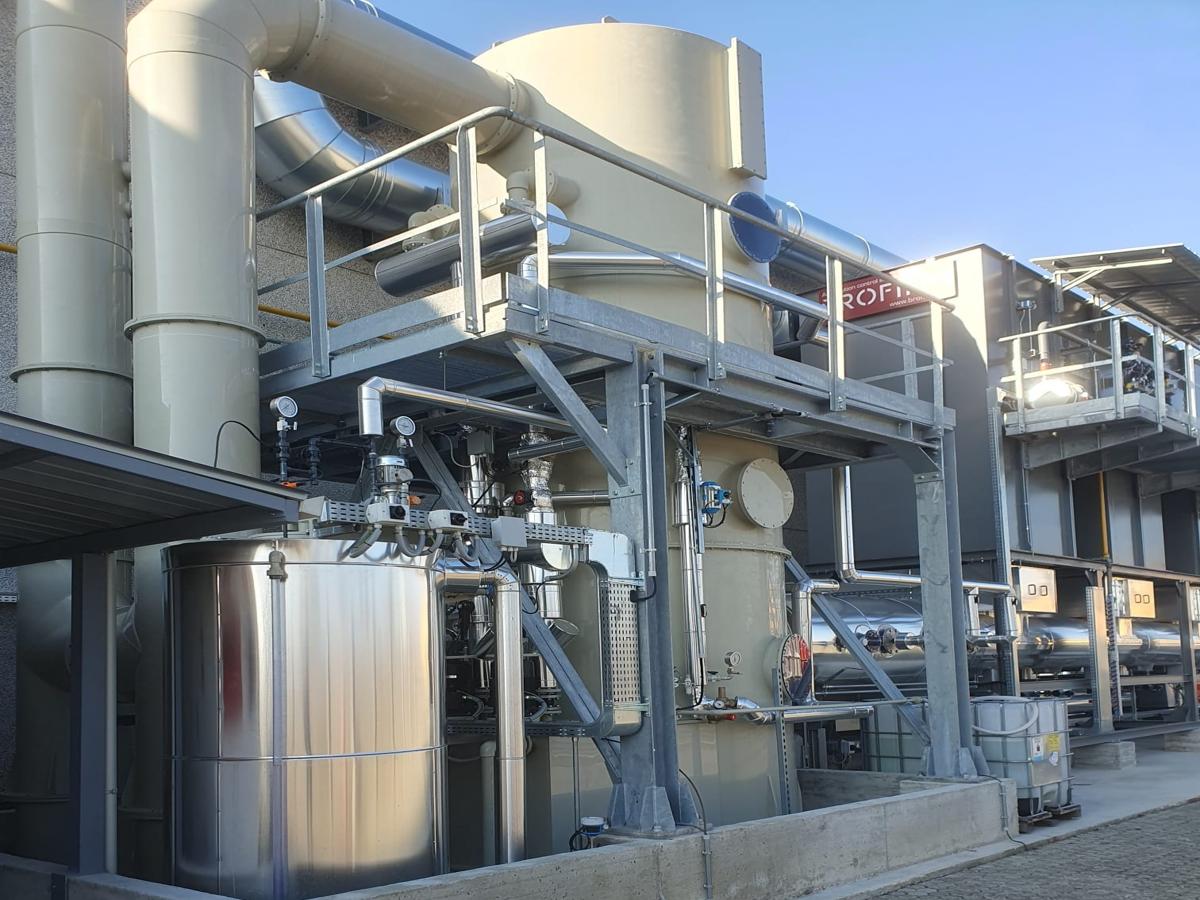Tower scrubbers are used for the wet abatement of different types of pollutants, normally dissolvable in water. Whereas the Venturi system is also for the abatement of dust.
Scrubbers are machines for the wet abatement of pollutants, normally dissolvable in water, such as acids, bases and soluble solvents, rather than pollutants such as dust, or oily or condensing mist which are physically separated from the effluent to be purified while remaining trapped in the scrubbing liquid. All of these machines work according to the principle of mass transfer of pollutants from the effluent to the scrubbing liquid.
There are vertical scrubbers normally in counter flow and horizontal scrubbers normally in parallel flow. Choosing one solution instead of the other mainly depends on the application. As a matter of fact horizontal scrubbers are normally applied in odour treatment plants where different types of pollutants such as acids, bases and odorous substances to be oxidised can be treated with an single machine with several integrated stages (up to 3).
The most common scrubbers are built vertically, also called washing towers. They are more efficient than horizontal systems. These systems also apply to the abatement of large quantities of pollutants due to the specific choice of packing, which can be random, structured or with plates. Different types of scrubbers are used based on the application. The following scrubbers are used for dust:
- With static bed with large amounts of inorganic material
- With floating bed in presence of dust
- Venturi scrubber in presence of dust, oily mist or other solid pollutants
Features and advantages
- Electrical switchgear with PLC and remote assistance.
- Structure fully airtight and built with adequate materials resistant to corrosion (PP, PE, AISI 304, 316, alloy…).
- High purification efficiency >99%.
- Easy to manage and use.
- Pre-abatement systems can be installed to treat complex effluents.
- Reduced maintenance.
Operating principle
The effluent is drawn into and conveyed inside a wet scrubbing system, typically vertical, where it is “washed” with the recirculating liquid. In fact these systems are also called scrubbing towers or washing towers. They are based on the principle of the mass transfer between the airborne pollutant and the recirculating liquid which can be appropriately added with specific reagents to further improve the overall abatement performance of the machine and to make it easily manageable. These machines are built to maximise the exchange surface and/or to increase as much as possible the close contact between the effluent and the liquid, so much so that structured, random or plate packing are installed inside of them. Not only can the scrubbers be used where an acid-base reaction is possible, for example to reduce the emission of hydrochloric acid or ammonium, but they also have a high odour abatement value, and if built with special attention, in the absorption process they can also abate specific classes of soluble VOC.
Plant engineering solutions
Different types of scrubbers are used based on the application:
- Static bed scrubber with large amounts of inorganic material.
- Floating bed scrubber in presence of dust.
- Venturi scrubber in presence of dust, oily mists or other solid pollutants.
Static bed scrubber
Static bed scrubbers are washing towers with high efficiency and effectiveness in abating soluble pollutants in recirculation liquid, normally water. At times the air coming from production can also be contaminated with halogenated compounds (containing fluoride, chlorine, bromine or iodine), or containing sulphur, phosphorus or dust (if present in low quantities).
Description of the plant
The static bed scrubber consists of a bed made in random, structured or plate material capable of transferring the pollutant from the air to the circulating liquid. This liquid is pumped to the top of the tower or roughly sprayed on the bed itself. Shortly before the treated effluent exits the tower, a demister is applied to capture the liquid droplets inside the machine.
Floating bed scrubber
The floating bed scrubber is a vertical wet abatement system where the speed applied to the effluent by the shape of the system makes spheres float inside the machine. The presence of these spheres effectively abates an effluent mix of inorganic, organic and dust pollutants. The fluctuations of the spheres allows them to clean themselves so that this machine can be applied in environmentally friendly sectors such as composting or environmental exhaust treatment where there are various types of dust and pollutants.
Description of the plant
The machine is called a floating scrubber due to the characteristic of having a bed of plastic material inside, typically spheres, which fluctuates while the effluent passes through. The presence of the plastic material increases the contact surface between the effluent and the liquid, while fluctuation allows the material to be self-cleaned thanks to friction of the spheres during operation. Obviously, a pump draws liquid from the storage tank which is sent to the top of the column and sprayed on the floating bed. A demister is applied downstream of the bed to reduce entrainment of the water droplets outside of the scrubber.
Venturi Scrubber
The Venturi scrubber exploits the Venturi effect which is intentionally created inside its throat. The water to be treated is introduced in parallel flow with the aqueous solution. Thanks to the close contact that the Venturi throat creates and therefore also to the turbulence of the streams thus created, the pollutants are separated from the effluents and encapsulated in the aqueous solution. These systems are normally used for pollutants consisting of dust or oil.
Description of the plant
The Venturi scrubber is built by applying an upright Venturi pipe. Effluent and reagent travel in the large part of the pipe in parallel flow and come into close contact in the tight passage section, namely the throat, inside of which the mass is transferred from the effluent to the circulating liquid. In the next enlarged section of the pipe, the streams slow down and the liquid droplets separate from the effluent which can be sent outside of the system after passing through the specific demister.


